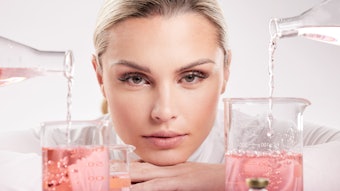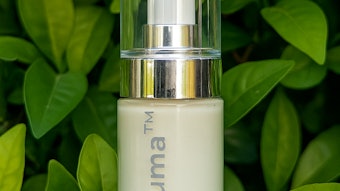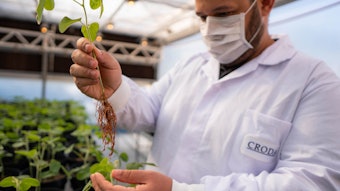
 In applications, Mitopure boosts cellular longevity by recycling and renewing the mitochondria, which is Timeline
In applications, Mitopure boosts cellular longevity by recycling and renewing the mitochondria, which is Timeline
This article is only available to registered users.
Log In to View the Full Article
 In applications, Mitopure boosts cellular longevity by recycling and renewing the mitochondria, which is "essential for maintaining cellular energy which supports muscle strength, cognition, immune resilience, skin vitality and other important benefits," per Timeline.Timeline
In applications, Mitopure boosts cellular longevity by recycling and renewing the mitochondria, which is "essential for maintaining cellular energy which supports muscle strength, cognition, immune resilience, skin vitality and other important benefits," per Timeline.Timeline
The beautyspan is our take on the “healthspan,” a concept that measures the length of time a person is healthy. That concept prioritizes not just longevity, but also quality of life. Similarly, the beautyspan refers to the duration of one’s skin and hair health/wellness, centering the discussion on holistic, preventive and regenerative strategies, rather than solely aesthetic solutions.
These concepts are already well underway in the industry. For instance, in January 2024, Swiss biotech health, aging and longevity company Timeline raised CHF 56M ($66 million) in series D financing, including strategic investments from L’Oréal and Nestlé. The investment interest centered on Timeline’s proprietary technology, Mitopure, which reportedly “unlocks a precise dose of the rare urolithin A molecule and promotes healthy aging.”
According to a study in Rejuvenation Researcha, “urolithin A significantly increased type I collagen expression and reduced matrix metalloproteinase 1 (MMP-1) expression. Urolithin A also reduced intracellular reactive oxygen species, which may be partially due to activation of the Nrf2-mediated antioxidative response.”
In applications, Mitopure boosts cellular longevity by recycling and renewing the mitochondria, which is “essential for maintaining cellular energy, which supports muscle strength, cognition, immune resilience, skin vitality and other important benefits,” per Timeline.
 Deinde's range comprises a Skin-Strengthening Serum ($88), Moisture Locking Face Stick ($36) and Purifying Whipped Cleanser ($32).Deinde/Debut
Deinde's range comprises a Skin-Strengthening Serum ($88), Moisture Locking Face Stick ($36) and Purifying Whipped Cleanser ($32).Deinde/Debut
“We think what’s next in skin care will be a shift in the industry to focus on sustaining skin health and promoting the longevity of healthy skin, a different philosophy from anti-aging skin care,” noted Dominique Gagnon, VP of consumer brands at Debut.
Estée Lauder has also gotten into the act. Its new Skin Longevity platform coincides with the formation of a cross-disciplinary group of longevity experts who will “educate and empower consumers to rethink how they approach skin care and lifestyle” to shift from an anti-aging mindset to an age reversal focus.
The brand’s Sirtivity-LP ingredient technology is at the core of the brand’s age reversal activities. The technology targets sirtuins in skin, which are a family of seven “NAD+ dependent proteins” central to cellular functions impacting the skin, including “aging, UV damage response, oxidative stress, and wound repair.”
Sirtivity-LP has been applied as the hero ingredient in Estée Lauder’s new Re-Nutriv Ultimate Diamond Transformative Brilliance Soft Crème, which reportedly “reveals visible age reversal starting in just 14 days.”
Suppliers are also leading the longevity charge. During the 2023 SCC annual meeting in New York, Silab presented a preview of what appears to be a forthcoming ingredient technology designed to reduce senescence-associated secretory phenotype (SASP) secretion. The Ginkgo biloba-derived active was said to be inspired by the longevity of supercentenarians and their potent immune systems, as well as their innate ability to efficiently eliminate senescent cells.
Senescent cells secrete SASP, which can harm healthy surrounding cells. Silab uncovered, ex vivo and in vivo, a significant break starting at the age of 60 when senescent cells begin to accumulate, altering four parameters in skin: elasticity, wrinkles, senescent spots and complexion radiance. Furthermore, while young immune systems easily recognize and eliminate senescent cells from the skin, aging can break down immune cell communication, allowing senescent cells to evade elimination, also known as immunoevasion.
The new Gingko biloba-derived active from Silab was reportedly shown to reduce SASP secretion, thus restoring the communication with immune cells and, in turn, improving the elimination of senescent cells from aged skin. Results showed significant improvements in skin density and elasticity, per Silab, as well as reduced wrinkles, boosted epidermal renewal and enhanced complexion radiance after 28 days of treatment.
Elsewhere, Mibelle Biochemistry’s new RejuveNAD technology naturally stimulates the endogenous regeneration of NAD+ by activating the enzyme NAMPT, thereby making the skin appear as much as eight years younger.
By boosting the “longevity molecule,” NAD+, RejuveNAD is able to optimize cellular processes to simultaneously address “at least” five of the 12 hallmarks of aging, including mitochondrial dysfunction, cellular senescence, loss of proteostasis, epigenetic alteration and genomic instability.
 By energizing mitochondria and promoting DNA repair, RejuveNAD is able to make the skin appear eight years younger within 42 days, per clinical studies cited by Mibelle Biochemistry.Mibelle Biochemistry
By energizing mitochondria and promoting DNA repair, RejuveNAD is able to make the skin appear eight years younger within 42 days, per clinical studies cited by Mibelle Biochemistry.Mibelle Biochemistry
Zülli adds, “The aging process is governed by nine to 12 universally recognized mechanisms, often referred to as the hallmarks of aging. By counteracting these mechanisms, we can achieve an anti-aging effect. In this regard, ‘biohacking’ has emerged as a revolutionary trend, aiming to enhance and optimize an individual’s body, health and overall life experience.”
The executive notes, “A pioneering tool in this field is the determination of the epigenetic clock, which provides an accurate measure of the skin or body’s biological age, as opposed to the chronological age indicated in our passports. Innovative active ingredients are being developed to counteract some of these aging hallmarks, thereby reducing the biological age of the skin.”
Zülli concludes, “This emphasis on longevity and aging at a cellular level marks a significant departure from previous eras of ingredient innovation. In [the past], the focus of beauty products was primarily on mitigating external signs of aging, such as wrinkles and age spots. However, today’s longevity-boosting ingredients are designed to tackle the root causes of aging at a cellular level.”
March 2024 Ingredient Trend Tracker
In addition to ongoing longevity innovation, a wide range of ingredient technologies and themes have come to the fore in recent months.
2024’s Top-trending Ingredient?
According to a Beauty Pie reportb, ectoin, the multifunctional amino acid derivative, has experienced a 163% increase in Google searches over the six months ending November 2023. The ingredient is associated with strengthening the skin barrier, a claim that boomed in the last year.
Beauty Bio-factories for Sustainable Innovation
Endophytes are plant microbiota — symbiotic microorganisms that live inside plants and act as bio-factories for natural bioactive compounds that offer beauty benefits, including microbiome balance, anti-inflammatory and pro-aging effects, anti-pollution defense, and much more.
Provital’s new Triplobiome platform for the discovery and biotechnological production of plant endophytes as a source for cosmetic actives leverages these materials for sustainable innovation.
Notably, the platform can generate unique natural actives that don’t put undue stress on botanical sources.
The process reportedly identifies target plants, isolates endophytes (which can synthesize bioactive phytochemicals) from these plants, identifies key strains among these endophyptes and thereby generates new beauty actives.
The Mind-beauty Interface
The concept behind neurocosmetics harnesses materials that mimic the body’s endogenous neuromediators by binding to skin cell receptors to regulate skin functions and, ultimately, address issues such as blemishes. At the same time, these materials’ ability to bind to receptors may allow them to induce a sense of well-being, as well as other sensations, delivering a holistic wellness value proposition. To date, technologies have focused on calming, mood-boosting and even sleep-supporting concepts.
 During the 2023 SCC annual meeting in New York, Mathilde Frechet, Ph.D., of Clariant discussed the development and application of a light-biomimetic technology designed to stimulate “feel-good hormones and cognitive relaxation” in the service of lack of sunlight and dull skin.jes2uphoto at Adobe Stock
During the 2023 SCC annual meeting in New York, Mathilde Frechet, Ph.D., of Clariant discussed the development and application of a light-biomimetic technology designed to stimulate “feel-good hormones and cognitive relaxation” in the service of lack of sunlight and dull skin.jes2uphoto at Adobe Stock
According to Frechet, sunlight deprivation from indoor living, seasonal variation, etc., has dramatic negative effects, including depression and a decrease in vitamin D levels, serotonin (the feel-good hormone) and melatonin (to support sleep).
In its research, Clariant measured the relaxation effects on the mental state of individuals in response to a light simulator. The team observed benefits after one exposure 24 hours later. The group then attempted to replicate this effect in a neuroactive derived from the Sanguisorba officinalis (butterfly) plant via the company’s sustainable plant milking technology.
Per Frechet, thanks to the plant’s tormentic acid content, the neurocosmetic enhanced cognitive relaxation and skin complexion by amplifying the vitamin D pathway and hormonal production through skin opsin activation.
One neuro technology already on the market is Mibelle Biochemistry’s TiMood, which is based on the Himalayan timut pepper and reportedly improves neuronal function in the skin in the service of enhanced skin homogeneity. It also is said to positively influence users’ moods and emotional well-being.
“Neuroactive ingredients in beauty products, sometimes referred to under the umbrella term ‘neurocosmetics,’ are a relatively new development in the cosmetics industry,” says Mibelle’s Zülli. “These ingredients work by interacting with the nervous system, particularly the nerve cells in the skin, to achieve their effects. The potential benefits of neuroactive ingredients could include: skin health such anti-inflammation and soothing; anti-aging such as cell regeneration and activation of growth factors; and sensory experience such as heat, cold and pressure sensation.”
He adds, “But the true magic of neurocosmetics lies in the potential for mood and stress regulation. In this research the so-called skin–brain axis is addressed. First, studies show that the topical application of cosmetic actives on the skin can influence some mood parameters of the volunteers, leading to a sense of well-being. This groundbreaking research has given birth to a new category of products we’re calling ‘Emotional Beauty,’ creating a virtuous cycle of look good-feel good-look good.”
The Beauty of Plant Milking
 Clariant is one of the early adopters of plant milking technology, which led to the development of its Prenylium ingredient.Clariant
Clariant is one of the early adopters of plant milking technology, which led to the development of its Prenylium ingredient.Clariant
One key player in plant milking, Plant Advanced Technologies, has already established ingredient partnerships in beauty. In 2018, it facilitated the development of the anti-inflammatory active Equibiome from Seppic. Two years later, it partnered with Clariant on the anti-ager Prenylium and Rootness Energize, which targets several mechanisms responsible for under-eye circles and eye bags.
Menopausal Beauty
With an aging Gen X cohort transitioning into its menopausal phase, a number of brands and suppliers are addressing key concerns that come with this disruptive force.
In September 2023, for instance, Pierre Fabre Laboratories took a minority stake in French skin care and supplement brand MiYé, which focuses on women's hormonal balance and well-being from puberty to menopause.
 With an aging Gen X cohort transitioning into its menopausal phase, a number of brands and suppliers are addressing key concerns that come with this disruptive force.Cultured Images at Adobe Stock
With an aging Gen X cohort transitioning into its menopausal phase, a number of brands and suppliers are addressing key concerns that come with this disruptive force.Cultured Images at Adobe Stock
Vichy’s Neovadiol line is specifically formulated for peri- and post-menopausal skin and reportedly illustrates the brand’s commitment to supporting women in menopause. Meanwhile, Embr Labs’ Embr Wave is a wearable device designed to allow women to access immediate relief from hot flashes.
On the ingredient front, Roelmi HPC has announced ExceptionHYAL Blossom (INCI: sodium hyaluronate), which reportedly meets the HA physiologic need for vaginal mucosa-increasing glycosaminoglycans, aquaporins and protein synthesis, thus promoting hydration. It induces an amelioration of symptoms such as vaginal dryness, itching, pain and urinary urgency typical for women in menopause, per the supplier, thus improving the quality of life.
“Menopause, a natural biological transition, is accompanied by various skin alterations due to hormonal shifts,” says Zülli. “These changes can manifest as dryness, diminished elasticity, thinning and heightened sensitivity. Beauty brands catering to this demographic often prioritize ingredients that can assuage these symptoms and bolster skin health during and post-menopause. One such group of ingredients is plant estrogens, also known as phytoestrogens. These naturally occurring compounds, found in a variety of plants such as soy, have the ability to mimic the effects of estrogen in the body. They can assist in balancing hormone levels in the skin and body, potentially alleviating menopause-related symptoms. Isoflavones, like genistein, predominantly bind to the estrogen receptor beta and inhibit matrix metalloproteinases, which are responsible for collagen degradation.”
He adds, “As we age, the levels of sex hormones, including estrogens and androgens, decline in both women (a phase known as menopause) and men (referred to as andropause). Interestingly, both estrogens and androgens share the same precursor molecule, dehydroepiandrosterone (DHEA). Recent research has revealed that our skin possesses all the necessary enzymes for sex hormone synthesis, either from circulating DHEA or even through the local conversion of cholesterol into DHEA. Studies have demonstrated that an extract from the monk’s pepper can stimulate the formation of DHEA in cells, thereby offering an alternative approach to combat skin aging during menopause or andropause.”
Mibelle Biochemistry’s Densorphin natural active ingredient is based on a concentrated extract of monk’s pepper berries. The technology is said to stimulate the activities of β-endorphin and DHEA to increase the density and elasticity of skin while reducing the appearance of wrinkles.
Surgery-free Acne Therapies
 During the 2023 SCC annual meeting in New York, Sederma’s Alba Cico, Ph.D., previewed a new peptide to improve C. acnes-induced skin damage.Jacob Lund at Adobe Stock
During the 2023 SCC annual meeting in New York, Sederma’s Alba Cico, Ph.D., previewed a new peptide to improve C. acnes-induced skin damage.Jacob Lund at Adobe Stock
Per the presenter, these features are involved in formation of inflammatory lesions. The peptide also demonstrated efficacy against inflammatory markers and promoted several extracellular matrix proteins to reduce pockmarks. Skin surface improvements were measured after the use of a peptide-containing cream for two months, offering an alternative treatment to surgery.
Elsewhere, Azeco’s Azepur99 (INCI: azelaic acid) is a multifunctional ingredient that can help regulate melanin production by inhibiting the activity of tyrosinase — which can help lighten dark spots, age spots and post-inflammatory hyperpigmentation. It is also reportedly effective in treating acne and preventing future breakouts by reducing inflammation, killing acne-causing bacteria, decreasing sebum production and preventing the formation of new comedones. Furthermore, the technology is said to help fade acne scars.
Finally, Contipro’s Zinnerine offers a zinc hexapeptide complex that delivers retinol-like activity. It fights four key events leading to acne formation, per the supplier: Cutibacterium acnes overgrowth, inflammation, increased sebum production and hyperkeratinization. It also offers soothing effects, supports skin barrier function and reduces wrinkles, per the company.
Upcycled Beauty
 UBC works with a brewery less than 80 km from its U.K. manufacturing site to upcycle spent barley grain (itself locally sourced) left over from the brewing process. This material would otherwise go to waste.LIGHTFIELD STUDIOS at Adobe Stock
UBC works with a brewery less than 80 km from its U.K. manufacturing site to upcycle spent barley grain (itself locally sourced) left over from the brewing process. This material would otherwise go to waste.LIGHTFIELD STUDIOS at Adobe Stock
UBC has a Canadian partner that manufactures Barley Toniq to the U.K. operation’s specification, using locally sourced spent grain from a brewery in Quebec. As a result, UBC can provide sustainably upcycled material in both Europe and North America.
Barley Toniq is rich in proteins, peptides, polypeptides, amino acids and carbohydrates, delivering soothing and rebalancing effects to irritated skin, even at levels as low as 1-3%. Per the supplier, the ingredient features upcycled and microbiome-friendly propanediol, which contributes to the soothing effects.
According to UBC, the material can soothe redness by as much as 23% in two hours; one application is reportedly sufficient to halt further irritation. Applications include skin care and body care, particularly for sensitive and reactive skin.
Upcycled pollution defense: Biolie’s Biolime (INCI: aqua (and) propanediol (and) Citrus aurantifolia (lime) fruit extract) is a natural and COSMOS-certified organic aqueous extract from upcycled limes, produced with a reportedly zero-waste enzymatic extraction technology. The extract is said to protect skin cells when exposed to pollution, per the company, in part by boosting ATP production and preserving DNA.
Upcycled emulsifier alternative: CP Kelco’s Kelcosens Citrus Fiber is upcycled from citrus peels and certified by the Upcycled Food Association. The ingredient is intended for use in facial creams, serums and body lotions in which it offers stabilization of emulsions and a light texture. The cold processable material is an alternative to synthetic and natural emulsifiers, reportedly allowing for emulsifier-free formulas.
2 New Approaches to Collagen
 Delaying dermochronology? A new alternative to animal-derived collagen? Suppliers have new solutions to tackle key issues in beauty.puhhha at Adobe Stock
Delaying dermochronology? A new alternative to animal-derived collagen? Suppliers have new solutions to tackle key issues in beauty.puhhha at Adobe Stock
“Collagen is the key to skin’s structural integrity,” explained Mu, who noted it is lost at a rate of 1% per year with aging. “[We combined a] deeper understanding of molecular biology and fermentation expertise to create revolutionary vegan collagen.”
The human collagen III-inspired recombinant 50 kDa protein is produced in yeast and is reportedly 100% identical to the N-terminus of the human type III collagen. The company’s work addressed technological challenges for the industrialization of such recombinant protein as well as working mechanisms in terms of the extracellular matrix and dermal-epidermal junction structural stability and boosting.
At the same meeting, Silvia Pastor, Ph.D., of LipoTrue highlighted a plant-based human TIMP2 (TIMP metallopeptidase inhibitor 2) that can be applied to delay dermochronology caused by photoaging. Per Pastor, photoaged skin, with a scar-like dermis, is characterized by high MMP content that degrades the extracellular matrix and alters collagen density and organization. TIMP2 can counteract this degradation; in fact, Pastor noted, low levels of TIMP2 are found in keloid scars.
Using an MRNA technology to synthetically express human recombinant proteins or fragments of wild (unmodified and nonGMP) plants — essentially turning them into biofactories — LipoTrue was able to generate the desired protein and “get the proper post-translational modifications.” The resulting TIMP2 reduced UV-induced MMP production by 63% and in a test gel, and it successfully rebuilt collagen in dermal solar scars. Additional improvements were observed in terms of wrinkles and skin roughness.
A New Pathway to Skin Hydration
During the most recent SCC annual meeting, Christophe Toumit of Greentech discussed the application of fermented Gentiana lutea (yellow gentian) extract to reverse the slowing down of skin holobiont functions related to skin dehydration. Through metaproteomics, the company reportedly identified an apparent role that the skin holobiont plays in moisturization maintenance. The extract has reportedly been shown to restore this function and clinically shown to protect surface lipids, leaving the skin rehydrated. opening a new path to innovative targets in skin hydration.
Well-aging Tools
A Botox and retinoid alternative: Sirona’s GlycoProteMim is an anti-aging compound designed as an alternative to retinoid-based treatments, per the company. GlycoProteMim heightens cellular response to reactive oxygen species (ROS), according to the manufacturer, and boosts antioxidant SOD2, or superoxide dismutase 2. Designed for all skin types, GlycoProteMim also reportedly enhances hyaluronic acid synthesis and fibroblast proliferation to fortify the collagen 1 network.
In applications, the ingredient technology reportedly improves skin laxity and quality to boost UV protection and enhance the skin barrier. The result is a reduction in the visibility of wrinkles, diminished inflammation, and greater skin radiance.
Ginseng brightening and wrinkle reduction: Summit Cosmetics Europe’s Bio-GoldGinseng (GBG-Natural; INCI: Lactobacillus/panax ginseng root ferment filtrate) is rich in saponins (ginsenoside Rh2) and offers anti-aging properties, brightening of complexion and is reportedly nine times more active than classic ginseng. In applications, the technology taps melanin biosynthesis to brighten the skin; it also reduces the appearance of wrinkles.
Sustainable Functionality
A wide number of functional ingredients — from emollients to thickeners and beyond — have been launched, allowing for winning sensory experiences and enhanced sustainability.
 Applechem's SorbiThix L-100 enhances thickening across all traditional surfactant systems and integrates with modern surfactants like glutamate and isethionate.Rido at Adobe Stock
Applechem's SorbiThix L-100 enhances thickening across all traditional surfactant systems and integrates with modern surfactants like glutamate and isethionate.Rido at Adobe Stock
Sorbithix L-100 can functionally boost viscosity in glutamate surfactant systems without excessive usage rates, the supplier says, or adversely affecting sensory, rheological behavior, etc. Suitable for pH ranges of 4.5-7.5, the technology is non-irritating, gentle, mild and non-irritating and easy to use.
Elsewhere, Evonik’s Ecohance Soft Baobab (INCI: Adansonia digitata seed oil) is sourced from the Sahel region of Ghana. The natural botanical emollient offers skin caring, moisturizing and nourishing properties. It can be used in a wide range of natural cosmetic formulations, such as hand creams, hair conditioners and body butters.
Meanwhile, Cosphatec GmBH’s Cosphaderm E NGM natural is a liquid lysolecithin derived from soybeans that offers emulsifying and dispersing properties in aqueous environments and a high water-binding capacity. The ingredient also contributes to improved hair combability in conditioners and to a light and silky skin feel in leave-on formulations.
The supplier’s Cosphaderm PA-12, on the other hand, is an active organic acid derived from the soaking water of corn bran. Its chelating properties provide an antioxidant function by preventing the formation of reactive oxygen species while reducing the discoloration of cosmetic products.
Also on the emulsifier front is IOI Oleochemical’s Imwitor 372 P (INCI: glyceryl stearate citrate), a natural anionic O/W emulsifier that comes in flakes for easy processing. The material is compatible with multiple textures (lotion, cream and butter) or applications (baby, skin or hair care). In formulations, the ingredient provides uniform spreading and a smooth and soft after-feel.
In the delivery system space, Green Line Ingredients’ Imbue Shea (INCI: Water (and) Butyrospermum parkii (shea) oil (and) glycerin (and) polyglyceryl-6 stearate (and) glyceryl caprylate (and) Carthamus tinctorius (safflower) seed oil (and) xanthan gum (and) Rosmarinus officinalis (rosemary) leaf extract) is a microemulsion that performs as a delivery system. It can be used in a variety of products where intense moisture is the desired result. It is reportedly ideal for sprayable milks, wet wipe solutions, light lotions, rich creams and conditioning hair products, and is well-suited for hair products which target coarse, dry and damaged hair.
The company’s Imbue TEC (INCI: water (and) triethyl citrate (and) glycerin (and) polyglyceryl-6 stearate (and) glyceryl caprylate (and) Carthamus tinctorius (safflower) seed oil (and) xanthan gum (and) Rosmarinus officinalis (rosemary) leaf extract) is a microemulsion that performs as a delivery system in a variety of products where deodorization is the desired result. It is therefore ideal for foot creams, deodorizing washes and pet products, per the supplier.
In the multifunctional space, Lipoid Kosmetik AG usNeo (INCI: propanediol (and) Usnea barbata (lichen) extract (and) tromethamine (and) tetrasodium glutamate diacetate (and) water (aqua) (and) sodium hydroxide) multifunctional microbial control technology reportedly prevents the overpopulation of certain bacteria that lead to unwanted skin conditions such as body odor, blemishes or dandruff, without resorting to antimicrobials that can throw off the larger microbiome balance.
Another microbiome-friendly technology, BioAktive’s Lactomaizol (INCI: Zea mays (corn) kernel extract (and) Lactobacillus ferment lysate filtrate (and) Lactobacillus/rice ferment (and) glycerin (and) modified corn starch (and) betaine (and) xanthan gum (and) 1,2-hexanediol (and) phenethyl alcohol (and) propanediol) is a corn multigrain postbiotic active designed for gentle skin cleansing and sebum regulation.
Created using fermentation technology, the ingredient offers the following benefits: natural, soothing cleansing and skin barrier protection; gentle absorption of excess keratin and sebum; significant reduction in the production of excess sebum; skin smoothing with notable shrinkage of the appearance of pores.
FOOTNOTES
ahttps://pubmed.ncbi.nlm.nih.gov/30215291/
bwww.beautypie.com/blog/beauty-trends-report
cwww.wgsn.com/en/top-trends-2024










